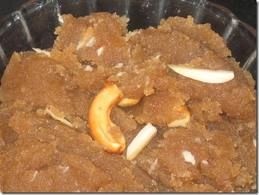Halva (halawa, alva, haleweh, halava, helava, helva, halwa, halua, aluva, chalva) refers to many types of dense, sweet confections, served across the Middle East, South Asia, Central Asia, West Asia, North Africa, the Horn of Africa, the Balkans, Central Europe, Eastern Europe, Malta and the Jewish world.
The term halva (Arabic: حلاوة ḥalāwah / حلوى ḥalwah), meaning "desserts" or "sweet", is used to describe two types of desserts:
- Flour-based – This type of halva is slightly gelatinous and made from grain flour, typicallysemolina. The primary ingredients are clarified butter, flour, and sugar.
- Nut-butter-based – This type of halva is crumbly and usually made from tahini (sesamepaste) or other nut butters, such as sunflower seed butter. The primary ingredients are nut butter and sugar.
Halva may also be based on numerous other ingredients, including sunflower seeds, variousnuts, beans, lentils, and vegetables such as carrots, pumpkins, yams and squashes.[1]
Halva can be kept at room temperature with little risk of spoilage. However, during hot summer months, it is better kept refrigerated, as it can turn runny after several days.




